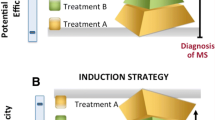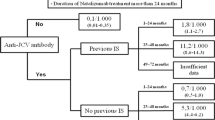Opinion statement
-
Given our current knowledge, there is a need for the early institution of immunomodulatory therapy, especially for patients with poor prognostic factors (motor and cerebellar symptoms, frequent disease exacerbations, and a high level of activity on magnetic resonance imaging [MRI]).
-
Patients who progress despite immunomodulatory therapy should be reevaluated in terms of diagnosis, development of neutralizing antibodies, or compliance. If a patient has a partial response to immunomodulatory therapy but his or her disease, as assessed by clinical and MRI criteria, remains very active, every effort should be made to modify disease progression by searching for an immunosuppressive therapy regimen before irreversible and considerable disability has accumulated.
-
For the majority of patients, multiple sclerosis (MS) is a chronic condition. Therefore, until a curative treatment has been developed, the available repertoire of immunosuppressive or immunomodulatory treatments should be assessed with respect to the possibility of long-term use. This is particularly important for new immunosuppressive drugs, such as cladribine or mitoxantrone, or for invasive procedures, such as total lymphoid irradiation or autologous bone marrow transplantation. For the latter treatments, experience with long-term administration is not available or the potential side effects (eg, cardiotoxicity with mitoxantrone) limit the cumulative dose. These considerations may limit long-term administration and thus the general usefulness of some drugs. Even with proven efficacy, we need to define the next step once treatment has to be discontinued. We should also address whether exacerbating disease by discontinuing an effective therapy is a potential hazard. What other therapeutic options remain once the current treatment is discontinued? Answers are not readily available at the moment, but the question should influence our decisions in the selection of traditional, well-studied or new, potentially promising therapies.
Similar content being viewed by others
References and Recommended Reading
The Canadian Burden of Illness Study Group: Burden of illness of multiple sclerosis. Part I: cost of illness. Can J Neurol Sci 1998, 25:23–30.
Lubin FD, Reingold SC: Defining the clinical course of multiple sclerosis: results of an international survey. National Multiple Sclerosis Society (USA) Advisory Committee on Clinical Trials of New Agents in Multiple Sclerosis. Neurology 1996, 46:907–911.
Weinshenker BG, Bass B, Rice GP, et al.: The natural history of multiple sclerosis: a geographically based study. I. Clinical course and disability. Brain 1989, 112:133–146.
Bourdette DN, Prochazka AV, Mitchell W, et al.: Health care costs of veterans with multiple sclerosis: implications for the rehabilitation of MS. VA Multiple Sclerosis Rehabilitation Study Group. Arch Phys Med Rehabil 1993, 74:26–31.
Martin R: Immunological aspects of experimental allergic encephalomyelitis and multiple sclerosis and their application for new therapeutic strategies. J Neural Transm Suppl 1997, 49:53–67. This article deals more extensively with the current concept of MS pathogenesis, especially its application in the design of new therapeutic strategies.
Swank RL, Dugan BB: Effect of low saturated fat diet in early and late cases of multiple sclerosis. Lancet 1990, 336:37–39.
Swank RL: Multiple sclerosis: fat-oil relationship. Nutrition 1991, 7:368–376.
Neu IS: Essential fatty acids in the serum and cerebrospinal fluid of multiple sclerosis patients. Acta Neurol Scand 1983, 67:151–163.
Fisher M, Johnson MH, Natale AM, Levine PH: Linoleic acid levels in white blood cells, platelets, and serum of multiple sclerosis patients. Acta Neurol Scand 1987, 76:241–245.
Dworkin RH, Bates D, Millar JH, Paty DW: Linoleic acid and multiple sclerosis: a reanalysis of three doubleblind trials. Neurology 1984, 34:1441–1445.
Hutter CDD, Laing P: Multiple sclerosis: sunlight, diet, immunology and aetiology. Med Hypotheses 1996, 46:67–74.
Bates D, Cartlidge NEF, French JM, et al.: A double-blind controlled trial of long chain n-3 polyunsaturated fatty acids in the treatment of multiple sclerosis. J Neurol Neurosurg Psychiatry 1989, 52:18–22.
Noseworthy J, O’Brien PC, Erickson BJ, et al.: The Mayo Clinic-Canadian Cooperative trial of sulfasalazine in active multiple sclerosis. Neurology 1998, 51(5):1342–1352.
Martinez M, Vazquez E: MRI evidence that docosahexaenoic acid ethyl ester improves myelination in generalized peroxisomal disorders. Neurology 1998, 51:26–32.
Freeman JA, Langdon DW, Hobart JC, Thompson AJ: The impact of inpatient rehabilitation on progressive multiple sclerosis. Ann Neurol 1997, 42:236–244.
Di Fabio RP, Soderberg J, Choi T, et al.: Extended outpatient rehabilitation: its influence on symptom frequency, fatigue, and functional status for persons with progressive multiple sclerosis. Arch Phys Med Rehabil 1998, 79:141–146.
Petajan JH, Gappmaier E, White AT, et al.: Impact of aerobic training on fitness and quality of life in multiple sclerosis. Ann Neurol 1996, 39:432–441.
Trapp BD, Peterson J, Ransohoff RM, et al.: Axonal transection in the lesions of multiple sclerosis. N Engl J Med 1998, 338:278–285. This article presents new pathologic evidence for axonal damage in multiple sclerosis.
Beck R, Cleary P, Trobe S, et al.: The effect of corticosteroids for acute optic neuritis on the subsequent development of multiple sclerosis. N Engl J Med 1993, 329:1764–1769.
Barnes D, Hughes RAC, Morris RW, et al.: Randomized trial of oral and intravenous methylprednisolone in acute relapses of multiple sclerosis. Lancet 1997, 349:902–906.
Sellebjerg F, Frederiksen JL, Nielsen PM, Olesen J: Double-blind, randomized, placebo-controlled study of oral, high-dose methylprednisolone in attacks of MS. Neurology 1998, 51:529–534.
Goodkin DE, Kinkel RP, Weinstock-Guttman B, et al.: A phase II study of i.v. methylprednisolone in secondary-progressive multiple sclerosis. Neurology 1998, 51:239–245.
Oliveri RL, Valentino P, Russo C, et al.: Randomized trial comparing two different high doses of methylprednisolone in MS. A clinical and MRI study. Neurology 1998, 50:1833–1836.
The INFB Multiple Sclerosis Study Group: Interferon beta-1b is effective in relapsing-remitting multiple sclerosis. I. Clinical results of a multicenter, randomized, double-blind, placebo-controlled trial. Neurology 1993, 43:655–661. First report of a phase III multicenter trial of Betaseron in multiple sclerosis.
The INFB Multiple Sclerosis Study Group and the University of British Columbia MS/MRI Analysis Group: Interferon beta-1b in the treatment of multiple sclerosis: final outcome of the randomized controlled trial. Neurology 1995, 45:1277–1285.
Jacobs LD, Cookfair DL, Rudick RA, et al. and the Multiple Sclerosis Collaborative Research Group: Intramuscular interferon beta-1a for disease progression in relapsing multiple sclerosis. Ann Neurol 1996, 39:285–294. Results of the phase III trial of Avonex in the treatment of relapsing-remitting multiple sclerosis.
The European Study Group on Interferon beta-1b in Secondary Progressive MS: Summary of results of the European interferon beta-1b trial in secondary progressive MS [speech]. Nice, France: 8th Meeting of the European Neurological Society; 1998.
PRISMS (Prevention of Relapses and Disability by Interferon beta-1a Subcutaneously in Multiple Sclerosis) Study Group: Randomised double-blind placebo-controlled study of interferon beta-1a in relapsing/remitting multiple sclerosis. Lancet, 352:1498–1504.
Rudick RA, Simonian NA, Alam JA, et al.: Incidence and significance of neutralizing antibodies to interferon beta-1a in multiple sclerosis. Multiple Sclerosis Collaborative Research Group. Neurology 1998, 50:1266–1272.
Lublin FD, Whitaker JN, Eidelman BH, et al.: Management of patients receiving interferon beta-1b for multiple sclerosis: report of a consensus conference. Neurology 1996, 46:12–18. This article is a very practical discussion of the details of the management of patients receiving interferon beta-1b.
Fridkis-Hareli M, Strominger JL: Promiscuous binding of synthetic copolymer 1 to purified HLA-DR molecules. J Immunol 1998, 160:4386–4397.
Arnon R, Sela M, Teitelbaum D: New insights into the mechanism of action of copolymer 1 in experimental allergic encephalomyelitis and multiple sclerosis. J Neurol 1996, 243(suppl 1):S8-S13. This is a very nice review of the current understanding of the mechanism of action of copolymer 1.
Johnson KP, Brooks BR, Cohen JA, et al.: Copolymer 1 reduces relapse rate and improves disability in relapsing-remitting multiple sclerosis: result of a phase III multicenter, double-blind, placebo-controlled trial. Neurology 1995, 45:1268–1276. Report on the phase III trial of copolymer 1 in relapsingremitting multiple sclerosis.
Fazekas F, Deisenhammer F, Strasser-Fuchs S, et al.: Randomized placebo-controlled trial of monthly intravenous immunoglobulin therapy in relapsing-remitting multiple sclerosis. Lancet 1997, 349:589–593.
Rodriguez M, Miller DJ, Lennon VA: Immunoglobulins reactive with myelin basic protein promote CNS remyelination. Neurology 1996, 46:538–545.
British and Dutch Multiple Sclerosis Azathioprine Trial Group: Double-masked trial of azathioprine in multiple sclerosis. Lancet 1988, 2:179–183.
Ellison GW, Myers LW, Mickey MR, et al.: A placebocontrolled, randomized, double-masked, variable dosage, clinical trial of azathioprine with and without methylprednisolone in multiple sclerosis. Neurology 1989, 39:1018–1026.
Goodkin DE, Bailly RC, Teetzen ML, et al.: The efficacy of azathioprine in relapsing-remitting multiple sclerosis. Neurology 1991, 41:20–25.
Kalanie H, Tabatabai SS: Combined immunoglobulin and azathioprine in multiple sclerosis. Eur Neurol 1998, 39:178–181.
Yudkin PL, Ellison GW, Ghezzi A, et al.: Overview of azathioprine treatment in multiple sclerosis. Lancet 1991, 338:1051–1055.
Hohol MJ, Olek MJ, Orav J, et al.: Treatment of progressive multiple sclerosis with pulse cyclophosphamide/ methylprednisolone: response to therapy is linked to duration of progressive disease [speech]. Minneapolis: 50th American Academy of Neurology meeting; 1998.
Weiner HL, Mackin GA, Orav EJ, et al. and the Northeast Cooperative Multiple Sclerosis Treatment Group: Intermittent cyclophosphamide pulse therapy in progressive multiple sclerosis: final report of the Northeast Cooperative Multiple Sclerosis Treatment Group. Neurology 1993, 43:910–918.
Goodkin DE, Rudick RA, VanderBrug-Medendorp S, et al.: Low dose (7.5 mg) oral methotrexate reduces the rate of progression in chronic progressive multiple sclerosis. Ann Neurol 1995, 37:30–40.
Goodkin DE, Rudick RA, VanderBrug-Medendorp S, et al.: Low dose oral methotrexate in chronic progressive multiple sclerosis: analyses of serial MRIs. Neurology 1996, 47:1153–1157.
Kappos L, Patzold U, Dommasch D, et al.: Cyclosporine versus azathioprine in the long-term treatment of multiple sclerosis—results of the German multicenter study. Ann Neurol 1988, 23:56–63.
Rudge P, Koetsier JC, Mertin J, et al.: Randomized, double blind controlled trial of cyclosporin in multiple sclerosis. J Neurol Neurosurg Psychiatry 1989, 52:559–565.
Multiple Sclerosis Study Group: Efficacy and toxicity of cyclosporine in chronic progressive multiple sclerosis: a randomized, double-blinded, placebo-controlled clinical trial. Ann Neurol 1990, 27:591–605.
Rice G and the Cladribine Study Group: Cladribine and chronic progressive multiple sclerosis: the results of a multicenter trial [speech]. Boston: 49th annual American Academy of Neurology meeting; 1997.
Bastianello S, Pozzilli C, D’Andrea F, et al.: A controlled trial of mitoxantrone in multiple sclerosis: serial MRI evaluation at one year. Can J Neurol Sci 1994, 21:266–270.
Edan G, Miller D, Clanet M, et al.: Therapeutic effect of mitoxantrone combined with methylprednisolone in multiple sclerosis: a randomized multicenter study of active disease using MRI and clinical criteria. J Neurol Neurosurg Psychiatry 1997, 62:112–118.
Hartung HP, Gonsette R, and the MIMS-study group: Mitoxantrone in Progressive Multiple Sclerosis (MS): a placebo-controlled, randomized, observer-blind European phase III multicenter study—clinical results [abstract]. Mult Scler 1998, 4(4):325.
Krapf H, Morrissey SP, Zenker O, et al. and the MIMSstudy group: Mitoxantrone in progressive multiple sclerosis (MS): a placebo-controlled, randomized, observer-blind European phase III multicenter study—MRI results [abstract]. Mult Scler 1998, 4(4):380.
Lycke J, Svennerholm B, Hjelmquist E, et al.: Acyclovir treatment of relapsing/remitting multiple sclerosis. A randomized, placebo-controlled, double-blind study. J Neurol 1996, 243:214–224.
Cook SD, Troiano R, Rohowsky-Kochan C, et al.: Treatment of patients with progressive multiple sclerosis with total lymphoid irradiation. In Handbook of Multiple Sclerosis. Edited by Cook SD. New York: Marcel Dekker, Inc.; 1996:489–506.
Wiles CM, Omar L, Swan AV, et al.: Total lymphoid irradiation in multiple sclerosis. J Neurol Neurosurg Psychiatry 1994, 57:154–163.
Cook SD, Devereux C, Troiano R, et al.: Modified total lymphoid irradiation and low dose corticosteroids in progressive multiple sclerosis. J Neurol Sci 1997, 152:172–181.
Devereux C, Troiano R, Zito G, et al.: Effect of total lymphoid irradiation on functional status in chronic multiple sclerosis: importance of lymphopenia early after treatment—the pros. Neurology 1988, 38(suppl 2):32–37.
Comi G, Rodegher M, Colombo B, et al.: Low-dose total body irradiation in chronic progressive multiple sclerosis: a double-blind, controlled, randomized phase II study [speech]. Boston: 49th annual American Academy of Neurology meeting; 1997.
Burt RK, Traynor AE, Cohen B, et al.: T-cell depleted autologous hematopoietic stem cell transplantation for multiple sclerosis: report on the first three patients. Bone Marrow Transplant 1998, 21:537–541.
Fassas A, Anagnostopoulos A, Kazis A, et al.: Peripheral blood stem cell transplantation in the treatment of progressive multiple sclerosis: first results of a pilot study. Bone Marrow Transplant 1997, 20:631–638.
Palm M, Behm E, Schmitt E, et al.: Immunoadsorption and plasma exchange in multiple sclerosis: complement and plasma protein behavior. Biomater Artif Cells Immobilization Biotechnol 1991, 19:283–286.
Vamvakas EC, Pineda AA, Weinshenker BG: Meta-analysis of clinical studies of the efficacy of plasma exchange in the treatment of chronic progressive multiple sclerosis. J Clin Apheresis 1995, 10:163–170.
Martin R, McFarland H: Experimental immunotherapies for multiple sclerosis. Springer Semin Immunopathol 1996, 18:1–24. This is a review of emerging experimental treatment options for patients with multiple sclerosis. It includes the rationale for treatment development in view of our current understanding of the immunopathogenesis of the disease.
Hohlfeld R: Biotechnological agents for the immunotherapy of multiple sclerosis. Principles, problems and perspectives. Brain 1997, 120:865–916. Extensive, thorough review of experimental immunotherapy in multiple sclerosis.
Author information
Authors and Affiliations
Rights and permissions
About this article
Cite this article
Bielekova, B., Martin, R. Multiple sclerosis: Immunotherapy. Curr Treat Options Neurol 1, 201–219 (1999). https://doi.org/10.1007/s11940-999-0004-x
Issue Date:
DOI: https://doi.org/10.1007/s11940-999-0004-x




